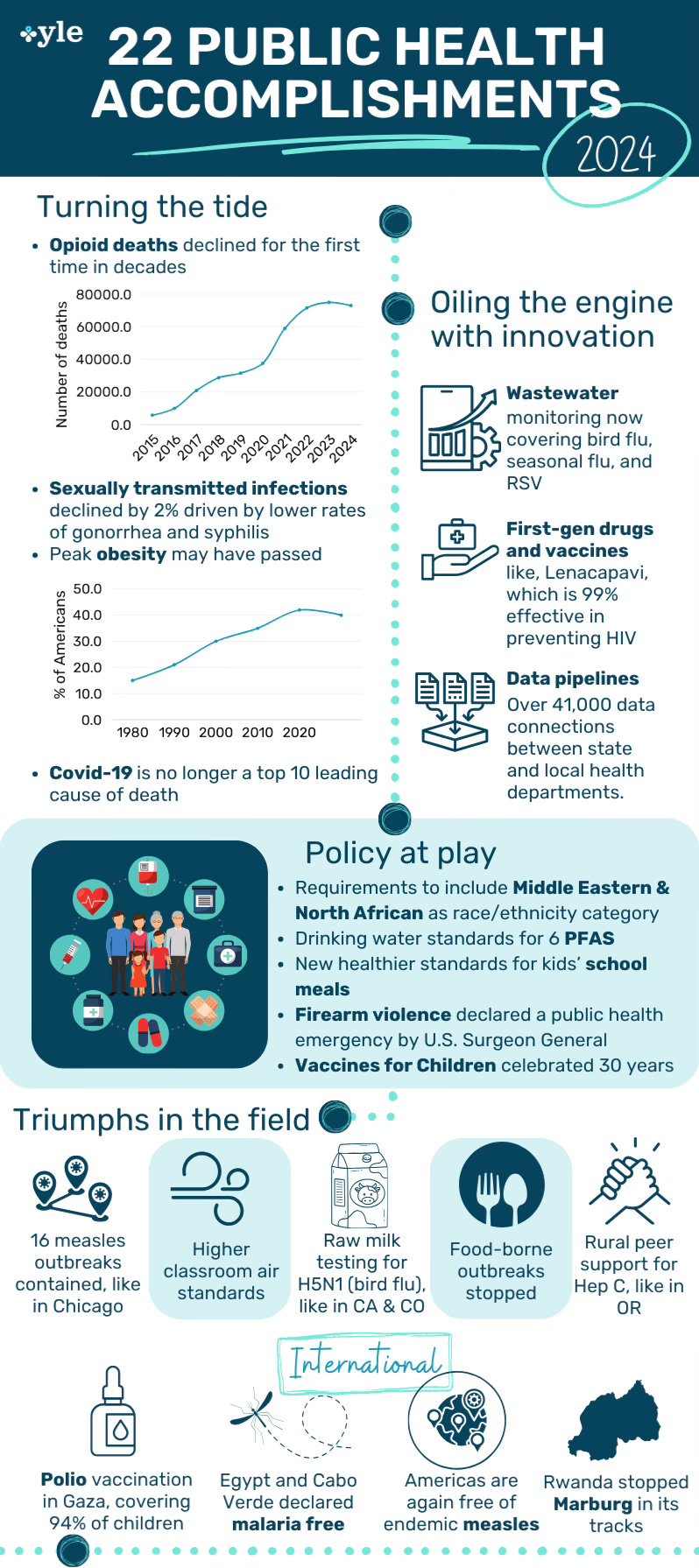Starting 2025 with a Bang (and a Few Blunders)
Hits, misses, and ideas to shape a smarter year in government
Welcome to the first TL;dr of the new year. As we navigate the possibilities and challenges of 2025, this edition takes a measured look at lessons from 2024 and ideas for the year ahead. From creative approaches to goal setting to the evolving media landscape, this issue offers thoughtful insights to help guide smarter governance.
We’ll also share a little humor and hard-earned wisdom in this week’s GovOvertime: Hits & Misses. Whether it’s avoiding hot mic disasters or finding innovative ways to explain public finances, there’s something here for everyone in government trying to communicate better, think smarter, and do more with less.
Here’s to a productive and inspired year ahead.
It’s Called a Premortem — and It’s the Most Productive Thing You’ll Do All Year
Entrepreneur Ron Shaich’s annual “premortem” ritual involves imagining himself on his deathbed and reflecting on what actions today will bring him self-respect and fulfillment in the future. The Wall Street Journal reports that each year, Shaich evaluates his relationships, health, work, and spirituality, setting specific goals and tracking progress quarterly. The premortem, a method adapted from business planning, helps him prioritize meaningful work and long-term success while avoiding regret. Here are some highlights:
Plan with Purpose: Shaich’s “future-back” planning method divides life into focus areas, identifies goals, and maps actionable projects.
Beyond Business: While rooted in corporate strategy, premortems can guide personal growth, improve health, and deepen relationships.
Avoid Regrets: Reviewing your life “in the seventh inning” ensures you adjust course while time is still on your side.
Living with Intention: Regularly revisiting priorities fosters a sense of peace and accomplishment, whether at work or home. Each year, Shaich evaluates his relationships, health, work, and spirituality, setting specific goals and tracking progress quarterly. The premortem, a method adapted from business planning, helps him prioritize meaningful work and long-term success while avoiding regret.
Moments We Forgot, Lessons We Shouldn’t
A WSJ look back at the top stories of 2024 reminded me how quickly we can forget momentous events. The good news is I have no problem recalling things like the February death of Alexi Navalny in a Siberian prison colony, the late March collapse of the Francis Scott Key Bridge, nor the Caitlin Clark mania that started during the NCAA women’s basketball tournament.
The bad news? I completely forgot all about the following:
Jan. 1: Earthquake and Tsunami in Japan. A powerful 7.6 magnitude earthquake strikes Japan’s west coast on New Year’s Day, triggering a tsunami. The disaster claims the lives of at least 475 people.
Jan. 28: U.S. Military Losses in Israel-Hamas Conflict. An Iranian-backed militia launches a drone attack on a U.S. base in Jordan, killing three American service members and injuring over 40. It marks the first U.S. military fatalities in the ongoing war.
Feb. 2: Retaliation Against Militias. The U.S. conducts airstrikes targeting Iranian-backed groups in Syria and Iraq in response to the January attack. Days later, a drone strike in Baghdad eliminates a commander linked to the incident.
Feb. 14: Kansas City Parade Tragedy. A celebratory parade for the Kansas City Chiefs turns deadly when a shooting leaves one person dead and 22 others, many of them children, injured. Authorities charge four suspects in connection with the attack.
March 18: Iceland Faces Volcanic Challenges. Iceland experiences multiple volcanic eruptions throughout the year, with scientists predicting decades of continued activity on the Reykjanes peninsula.
March 22: Concert Hall Attack in Russia. A terrorist bombing at a concert venue near Moscow kills at least 145 people. The Islamic State claims responsibility for the attack.
April 17: Dubai’s Historic Flooding. Unprecedented flooding disrupts travel at Dubai International Airport, causing mass flight cancellations and delays. Passengers are urged to avoid the airport during the crisis.
May 13: Walmart Cuts Corporate Jobs. Walmart announces significant layoffs in its corporate offices and ends much of its remote-work flexibility, joining a wave of companies scaling back post-pandemic workplace policies.
June 21: Deadly Heat During the Hajj. Extreme temperatures during Saudi Arabia’s Hajj pilgrimage result in over 1,170 deaths, marking the deadliest event since 2015.
Aug. 26: Zuckerberg Condemns Government Censorship. Mark Zuckerberg criticizes the Biden administration for pressuring Facebook to censor pandemic-related content in 2021, pledging resistance to similar demands in the future.
Sept. 12: SpaceX Milestone. Private astronauts on a SpaceX mission complete the first-ever commercial spacewalk, breaking new ground for the company’s space exploration efforts.
Sept. 16: Russia-Ukraine Dead Hits One Million. The combined deaths from the Russia-Ukraine conflict surpass 1 million, leaving long-lasting impacts on both nations as they grapple with dwindling prewar populations. I knew there were causalities — what I had forgotten was the death toll reaching that horrific milestone.
Nov. 9-17: Spain’s Flood Recovery Efforts. Following deadly flash floods that kill over 200 people in southeastern Spain, the country begins cleanup and rebuilding efforts.
Moral of the story: Don’t get too wrapped around the axle when things go sideways. Handle your bad news quickly and with aplomb. Then, let it go. The public will move on.
Charts that Make You Go, Hmmmm
Here’s one of those fascinating, animated bar charts showing changes over time you may have come across in your digital scrolling. This one shows how campaign funding has evolved over the past three decades. Spoiler alert: Elon does not top the list.
The New Media Reality: Fringe Becomes Mainstream
One of GGF’s favorite culture observers, Ted Gioia, argues alternative media is replacing legacy media at a rapid pace. Platforms like Twitch, YouTube, and Substack empower independent creators to surpass traditional giants in influence and reach. Legacy media struggles with declining relevance, aging audiences, and internal conflicts, while fringe creators — podcasters, gamers, and influencers — command massive audiences and redefine cultural consumption. This trend will likely extend beyond journalism into music, movies, and video games, with individual creators competing head-to-head with established industries using AI and new tools.
Here’s why this matters for government professionals:
Don’t Fear New Channels: Governments should explore alternative platforms like podcasts, Twitch, and Substack to reach younger, digitally native audiences.
Small Can Be Mighty: Embrace grassroots content creation to build trust and engage the community — large budgets are no longer prerequisites for high-impact outreach.
Stay Relevant: Traditional communication strategies must adapt to evolving media consumption patterns to maintain relevance and effectiveness.
Gov Overtime: Hits & Misses
Hot Mic, Hot Mess. After a Dec. 3 public meeting blooper where Fort Smith, Arkansas, City Administrator Carl Geffken seemingly called citizens “stupid,” the board showed him the door faster than you can say “utility advisory committee.” The unanimous vote to fire Geffken earned applause from the audience and some heartfelt public apologies to the offended speaker. Pro tip for public officials: Treat every mic like it’s live — because it just might be the last thing keeping you employed. 🎤🔥
Public Health Wins the Year. Our friends at Your Local Epidemiologist (YLE) wrapped up 2024 with a terrific infographic highlighting 22 major public health accomplishments. From declining opioid overdoses to landmark policies like kids’ meal reforms and first-ever PFAS drinking water standards, the wins keep stacking up. Oh, and cervical cancer rates among young women? Down, thanks to the HPV vaccine. Bottom line: Public health professionals are crushing it — even on a shoestring budget. Let’s cheer on their relentless efforts as we head into 2025! 🚑✨
Cracking the Code on Finance Communication: The GFOA’s Mental Model Makeover Challenge is tackling one of the biggest hurdles in government communication — explaining finances in a way that actually makes sense. By turning complex concepts like reserve funds into relatable analogies (hello, savings account), this challenge gives communicators new tools to simplify public finance for their audiences. With a raffle prize and a Feb. 28 deadline, this is a golden opportunity to level up your messaging game and help your community make informed decisions. Who said finance talk couldn’t be relatable and fun? Not me, I assure you. 💡💸
Onward and Upward.






